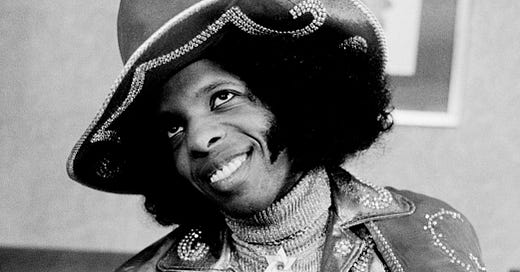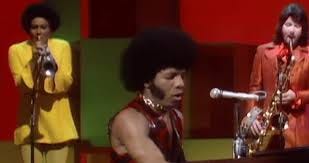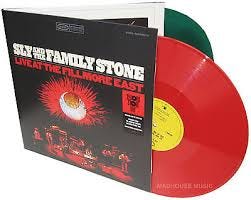Sly Lives!/Live Sly!
A trip though the video archives inspired by the incandescent new documentary Sly Lives!
If there’s a quibble with Questlove’s joyous, crisply edited and thought-provoking documentary about Sly Stone — Sly Lives! (Aka The Burden of Black Genius), which arrived last week — it has to do with the limitations of time and space confronted by all filmmakers.
These include: How long to dwell on the artist immersed in the work, and when to pivot to others discussing the work and its impact from a distance? How to balance performance against context?
Such decisions about duration are tricky with popular music, for obvious reasons: Should the filmmaker cut away before the climactic moment of a beloved refrain, he or she risks losing the viewer’s trust/goodwill. On the flip side, too much history or analysis can squash the spirit of celebration that prompted the project in the first place. It’s a dance.
Of course the degree of difficulty is doubled or tripled when it comes to Sly and the Family Stone. The band’s performances in its early ‘70s heyday were so brazenly fierce and gloriously alive — within minutes of taking the stage, these musicians summoned (and then expertly controlled) an incendiary whirlwind of sound. They reached peak rhythmic lock just getting a groove started. There is real magic (as well as a nice music lesson) in witnessing how effortlessly they did it. And where they took each version of a well-known tune.
A few times during Sly Lives!, I found myself with clasped praying hands (alas, a common position these days), hoping that the excerpt would linger long enough to show this musical development. Please stay with this moment so we hear how, after the drum fill, the band begins to levitate. Sometimes the film does stay, sometimes not. File the disappointments under: The Endless Anguish of the Cutting-Room Floor.
Sly Stone shared a thought about that in his October 26, 1973 appearance on The Midnight Special. Looking around at the cameras in the studio, he says “There’s some things you can sing that don’t have a lot to do with television and movies or anything else. It’s got to do with what you feel inside. And if you want to get higher, you’re gonna sing along with me.” There’s a restriction that prevents playing on other sites, but here’s the link.
The apex years of Sly and the Family Stone live are, happily, well documented. In addition to many bootlegs, the official releases include an expansive slice of the early band (from 1968) Live at the Fillmore East, and The Woodstock Experience, which captures the band’s historic performance in surprisingly crisp sound.
Curious to find full-length versions of songs featured in the film, I asked Dr. Google to fetch whatever live performance clips exist on the interwebs. There are many, of wildly variable audio and video quality.
Here we must digress into an obligatory note about ownership: It’s possible that those who own the footage used in Sly Lives! placed restrictions on how long an excerpt could be, and any secondary use of the material. That’s because in the wild-west environment of YouTube, those posting full concerts or TV appearances (sometimes captured on VHS recorders!) are frequently not the rights holders. It’s a tricky area. The below links are not intended to harm persons or corporations who own the material (sadly but predictably, few of them are named Sly Stone). Rather, they are provided as educational resources. If you’re a musician trying to learn how to move people, these links, should they actually open (!), offer valuable insights into the approaches used by a music genius and his torrid band.
The Ed Sullivan appearance heard briefly on Sly Lives!
European performance from 1970, with erratic closeup camera work. (Note the close captioning!)
A 1968 performance on a show called Kraft Music Hall, filmed in an NBC studio in Brooklyn 1968. (Ed McMahon is the show’s host).
Two live-in-studio performances shared by Sony Music, simply dated 1973.
Another studio recording, this one from ABC’s In Concert show in 1974….
There are more. As I watched multiple versions of the hits, it was interesting to pick up slight changes in tempo from one version to the next, the ways some of the horn parts evolved, and how certain settings subtly impacted the band’s energy. (One illustration, among many, is on this 1974 version of “I Want To Take You Higher” from Soul Train.)
It’s easy to marvel at the intensity of the music — and astonishing to think that some of it was captured for broadcast TV in an era when music programming was considered a viable thing. Sure, we’re in an entirely different media environment. Sigh. Today it’s possible to mainline the work of Sly and the Family Stone or any other reasonably prolific artist 24/7, remaining forever inside the bubble of one’s choosing.
That’s great, but different from the experience of encountering something that’s thoughtfully shot and presented for a general TV audience. In the new paradigm, you control every encounter with art. In the old one, where Sly and the Family Stone thrived, unsuspecting viewers found themselves taken higher by something they maybe didn’t know about ten minutes before. There’s electricity in that.
Related Reading: This Echo Locator from 2021, on the alternate mixes/performances of Sly and the Family Stone’s Fresh!









I had the same minor quibble, but what a celebration that doc is! There were points where I wanted to get up and move my cement hips.
Very cool. Haven't seen the doc yet, but have heard Questlove's interviews. (He's fucking everywhere). You are right about his live performances. I really wasn't dialed into Sly until I saw the Woodstock film and was completely blown away. I wish I'd actually seen him live.